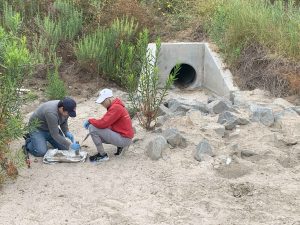Initial dry-weather sampling completed for study investigating BMPs’ potential to remove microplastics in runoff

SCCWRP and its partners have completed an initial round of dry-weather sampling of the engineered media inside six biofiltration BMPs (best management practices) as part of an ongoing study investigating the effectiveness of these systems at removing microplastics from runoff.
The sampling, completed in July, will enable researchers to quantify the levels and sizes of microplastic particles that have been retained inside the biofiltration BMPs since the systems were initially constructed as many as six years ago.
Researchers believe this type of analysis will generate different insights than the study’s wet-weather sampling work, during which researchers are measuring the microplastics levels entering and exiting the flow-through systems.
In particular, researchers anticipate the BMP media analysis will shed light on whether biofiltration BMPs are capable of capturing only larger microplastic particles or if the systems are capturing smaller particles as well.
The two-year study, being conducted in partnership with California State University, Long Beach and California State University, Los Angeles, is working to understand how specific characteristics of different types of BMP engineered media influence the removal of microplastics from runoff.
More news related to: Emerging Contaminants, Stormwater BMPs, Trash Pollution